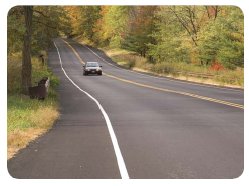U.S. Department of Transportation
Federal Highway Administration
1200 New Jersey Avenue, SE
Washington, DC 20590
202-366-4000
| < Previous | Table of Contents | Next > |
The High Risk Rural Roads Program (HRRRP) was initiated to address safety on the lower functional class of rural roads – a segment of the system often overlooked.
The Safe, Accountable, Flexible, Efficient Transportation Equity Act: A Legacy For Users (SAFETEA-LU) established the Highway Safety Improvement Program (HSIP) as a core Federal aid program administered by the Federal Highway Administration (FHWA) beginning in FY 2006. The purpose of the HSIP is to achieve a significant reduction in traffic fatalities and serious injuries on all public roads. Over $1.2 billion is authorized annually through FY 2009 for the HSIP. The High Risk Rural Roads Program (HRRRP) was established through a set aside from each State's apportionment of HSIP funds for construction and operational improvements on high risk rural roads. The set aside is a total of $90 million per year nationally and is applied proportionally from the States' HSIP apportionments.
After 4 years of the HRRRP, the overall obligation rate for the program has remained low. Given the HRRRP potential to improve rural road safety, this has been a major concern to the Federal Highway Administration (FHWA), proponents, and stakeholders of the program. FHWA embarked on a research project to identify the challenges the States face in implementing the HRRRP as well as any lessons learned and noteworthy practices those who had implemented HRRRP wished to share.
The research found the most common difficulties the States experience with implementation of the HRRRP include:
Collecting and analyzing crash data can be a challenge, especially at the local level. The HRRRP regulation requires a crash rate to be calculated to identify eligible roadways. Typically, traffic volumes are used as the exposure data to calculate crash rates. Many States do not have traffic volume data for local routes, causing a gap in the ability to compare roadways. However, States are using diverse types of exposure data to determine crash rates as well as innovative ways to collect and use the data to support HRRRP implementation. For example,

When selecting projects, a number of stakeholders are typically involved. The number and types of agencies invited to the table during the selection process varies by State. States have developed methodologies to choose the best projects for implementation given their State-specific policies. For example,
Research showed that collaboration between agencies at all levels in a State is an essential element to the implementation of the HRRRP. This was shown in several forms, including, but not limited to:
The HRRRP, like many new Federal-aid programs, comes with some administrative requirements. Available funds for the HRRRP are generally low and many States have adopted noteworthy strategies to make efficient use of these funds. For example,
Fatality rates on rural roadways continue to outpace those of urban roadways. The HRRRP has brought new attention to the safety needs on rural roads. States have taken advantage of this funding source and implemented numerous projects across the country to reduce potential fatalities and serious injuries on rural roadways. However, the program is significantly under-obligated.
This document identifies common challenges and shares noteworthy practices and lessons learned. States can use these documented practices to launch their HRRRPs, identify next steps for a program already moving forward, or implement noteworthy practices to improve an established program. Implementing the HRRRP can make a real difference in rural road safety, and the complexity of implementing the program should not inhibit States in their pursuit of improved safety on rural roads.
| < Previous | Table of Contents | Next > |
